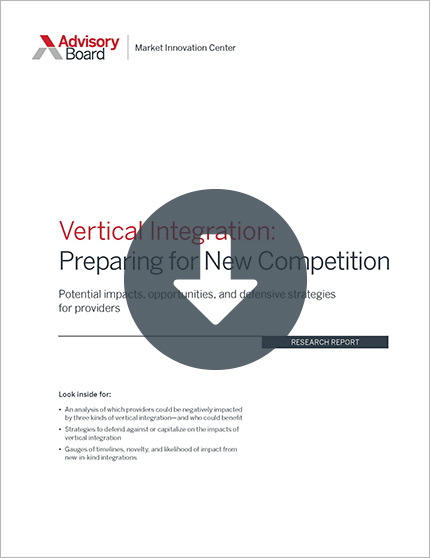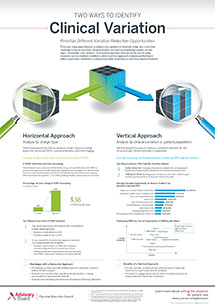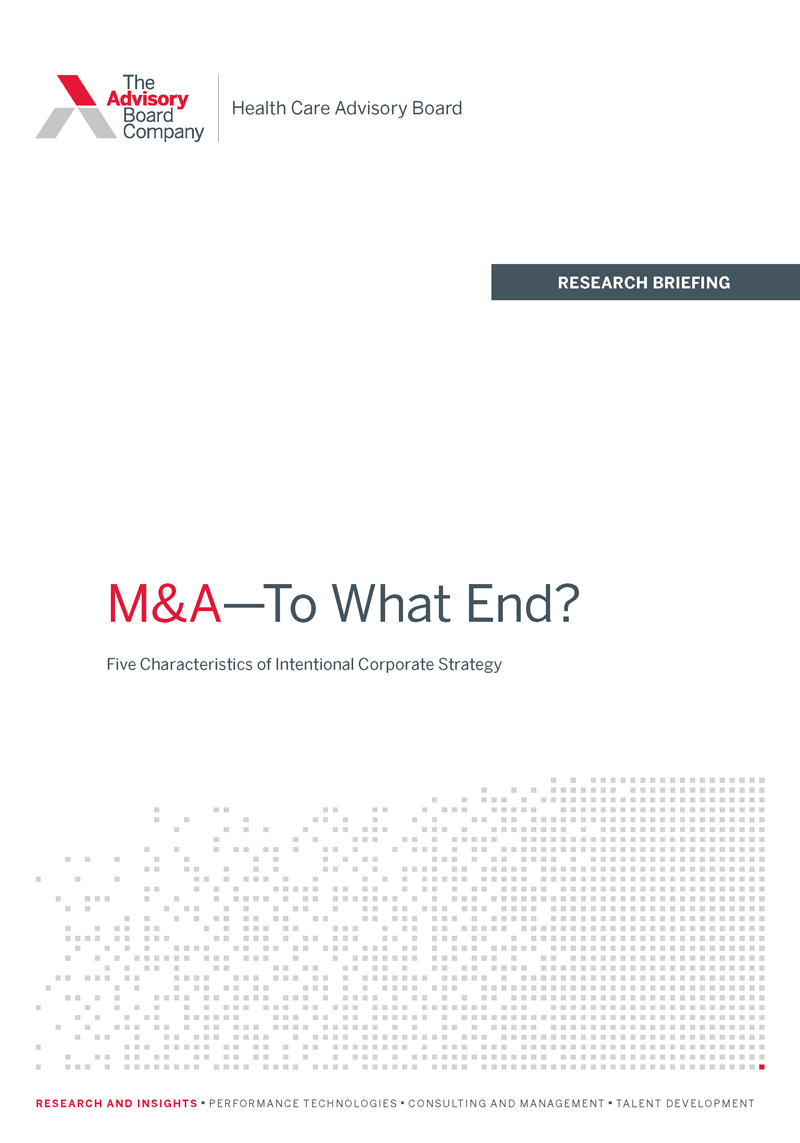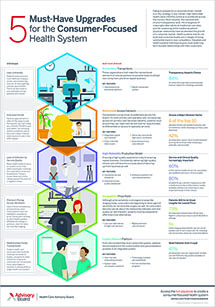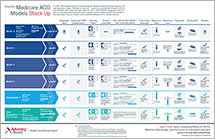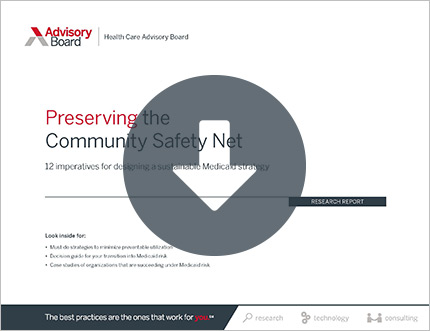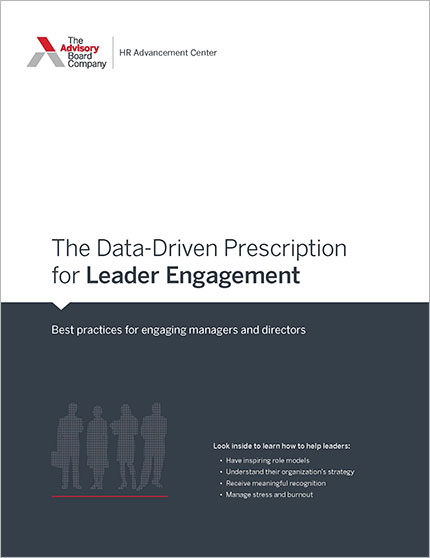Auto logout in seconds.
Continue LogoutWelcome to the "Lessons from the C-suite" series, featuring Managing Partner Eric Larsen's conversations with the most influential leaders in health care.
In this edition, Dr. Nick Turkal and Jim Skogsbergh, co-CEOs of Advocate Aurora Health, talk with Eric about what they're hoping to prove as co-CEOs, why they consider the multi-state enterprise a contiguous merger, their "admirable" differences that make their partnership work, and more.
Nick Turkal, co-CEO of Advocate Aurora Health
Question: Let's start with the basics—both Advocate and Aurora were immensely successful systems in their own right. Now you've combined to form Advocate Aurora Health, the 10th largest not-for-profit, integrated health care system in the country, serving an estimated three million patients each year. What was the motivation here?
Nick Turkal: A couple of things. First, we had a strong belief that size and scale would be important, not for scale in and of itself, but for what we could do together that we couldn't do separately. Second, we felt it was the right time to come together because both organizations were coming from a position of strength—slightly different strengths, but both independently very strong. With that in mind, our immediate strategy is offering high-quality, safe care at a lower cost than what's on the market. Long-term, we're going to figure out how we, as a top-10 health system, can transform the industry and reposition health care in a way that's going to help our patients.
Jim Skogsbergh: That said, neither Nick nor I believe past success is a guarantee of future success. We're running hard every day, and looking over our shoulders a bit at the forces chasing us. So one of the things I like about this transaction is that it opens up possibilities for us; there are things that we couldn't do independently that we can do now as a $12 billion organization—we can be the disruptor, not the disrupted.
Jim Skogsbergh, co-CEO of Advocate Aurora Health
Of course, just because you have a bunch of different doors open to you doesn't mean you have to walk through every single one. We are thoughtful and deliberate, and we're going to place our bets carefully. But I like scale for that leverage, along with all the other reasons: recruitment, retention, quality, safety, and making health care more affordable.
Q: Let's dive a bit deeper into this notion of scale, because the combined Advocate Aurora enterprise—with 70,000 employees and 27 hospitals—is by our industry standards a behemoth. But when you compare it with some of the recent non-traditional, vertical combinations in the broader healthcare ecosystem—CVS-Aetna, Cigna-Express Scripps, or even the horizontal health system mergers like Dignity-CHI—$12 billion isn't that big anymore. Given today's market, how are you viewing scale?
Skogsbergh: Scale is relative, right? I agree with you, Eric—we might be large within our space, as it's defined today, but we're competing and/or partnering with organizations that are 10 or 20 times our size. That's not lost on us. At the same time, there's also some sense of "not having to outrun the bear, you just have to outrun the person next to you"—and we certainly want to win in our own backyard.
But at the end of the day, we've got to win on a larger scale, too. We're going to work hard on generating economies of scale. It's going to tremendously improve our core operations. We're going to have the opportunity to peak on a larger, grander scale than we've done historically.
Turkal: When you think about the pressure on operating margins that we're seeing across the country, or about changes in utilization for inpatient care—and you consider that alongside what we need to be investing in digital, telehealth, and consumerism—it's a bad mix unless you're a large enough organization to make those investments. So that's where we get excited about size and scale. It's not the fact that you're bigger—it's what do you do with that.
Q: In your opinion, what makes this a compatible merger? How do you think your systems complement each other? What skillsets do you admire most about each other's system?
Turkal: We're very similar in our core beliefs about health care, but when it comes to skillsets, we've got some real differences. Advocate's approach to full-risk contracts in the Chicago market has been really interesting to watch, as has the system's population health skillset: building a very large and complex, clinically integrated network of physicians. They've saved taxpayers tens of millions of dollars annually through this approach. That's fantastic work, and we think much of that work is very transferrable, and quickly transferrable, across the larger organization.
Skogsbergh: Similarly, there's a great deal that we admire about Aurora. We love Aurora's integration. They are more tightly integrated and standardized than we are. Aurora also has a very robust direct-to-employer capability. There's not a lot of that in Illinois—at least not yet—but we really admire Aurora's direct-to-employer capability.
But as Nick pointed out, while there certainly are differences between us—differences we admire—it's the commonalities that really get us. We just line up on our commitment to value, to safety and health outcomes, to making health care more affordable, to being a great employer and a great community citizen. And Nick and I agree that the big issues in our nation are the consumer's concerns and frustrations about cost and quality and safety and service. That's where the industry needs to go to work. Otherwise, we're going to get run over.
Q: Jim, you mentioned the rigor Aurora has brought to its work around standardization. Now of course you're combining organizations with different regulatory environments, different reimbursement environments, and different payer configurations. How will you jointly pursue further clinical standardization and the elimination of unwanted care variation?
Skogsbergh: Our combined organization already has a common self-interest, a common desire, and a common commitment, so we don't have to sell each other on dealing with clinical variation—we depend on it. We both have the same incentives, and that's key when taking on full risk.
Turkal: And our measurement is not as different as you might think. We share a lot of similarities in terms of our ventures and the clinical variations we're targeting, so I think it's a relatively easy coming together of our respective quality and care management programs to get better outcomes.
I'd also add that Advocate's implementation of Epic has been a huge help to our clinical folks on the Aurora side, making them feel very comfortable that they're all partners, standardizing clinical care, and reducing medication errors. That effort will help to bring the organization together, not only in terms of an overall unification on data, but by making the combined organization feel like one system more quickly.
Mergers and acquisitions
Q: Let's turn for a moment to 'non-contiguous' mergers, because the synergies that those mergers—especially multi-state enterprises—can capture can be elusive, and neither of your states is particularly blessed with population growth. Now based on the (occasionally correct) Google Maps, your organizations are about an hour and 41 minutes apart, roughly 92.9 miles up and down I-94. How are you planning to overcome the attendant challenges presented by a non-contiguous merger, if that's how you'd identify?
Turkal: Eric, we actually consider that contiguous. It’s interesting—all that area that used to be farmland between Chicago and Milwaukee is no longer farmland. It's all filled in, essentially becoming a contiguous market. We have many patients who cross over the border both ways right now.
Of course, we want to take advantage of that and make sure we really are acting like one market. We don't expect patients to go back and forth from Milwaukee to Chicago very often—maybe just for transplants and some high-end or unusual procedures. But in terms of actual markets touching, we're very close, and we're going to fill in those gaps. And we only have two states to deal with, not 18, which we think is a big advantage.
Skogsbergh: For lack of a better word, you might call our approach a density model. We've got areas in each state that have big populations—Milwaukee in Wisconsin and Chicagoland in Illinois—so that's where we're going to focus our population health efforts. But we are mindful of the multi-state phenomena that you described. We're watching that closely and carefully, and we're talking to our colleagues who are in the thick of it.
Q: Where will you find cost synergies from the merger? Clearly opportunities will arise from sharing competencies you've each developed across clinical variation reduction, care delivery model innovation, extension of your population health management acumen, and continuing the move toward assuming more delegated risk. On the other hand, it seems some of the other, more traditional cost rationalizations may be off the table—as an example, you are intentionally maintaining two organizational headquarters and two CEOs.
Turkal: Well, I would say that some of those [traditional mechanisms] are still the table.
Skogsbergh: The fact that we have two offices is more of an acknowledgement that we don't need to get everybody terribly anxious about this. Our legacy organizations are strong, and we can be thoughtful and deliberate, and take our time to do it right—we don't have to shove these things together within a three-week timeframe.
Now, that doesn't mean that we can't bring these two organizations together, and the back-office work is exactly where we'll go. Nick and I have acknowledged that if it doesn't touch the patient, we want to go there aggressively, go hard and go fast. When it touches the patient, we want to slow down, be thoughtful, be deliberate, and get a lot of input from clinicians and caregivers.
So you'll see the typical synergies around supply chain and bringing the finance and public affairs departments together, those kinds of things. But there are other synergies as well, such as our investment income. We love the margins in Wisconsin, and they love the balance sheet that we have in Illinois. So just by combining our portfolios—just taking the cash of Aurora and maybe putting it in the Advocate portfolio—we'll see an estimated $40 or a $42 million lift annually, which you can compound.
Q: Have you quantified the estimated (or targeted) cost synergies? How are you prioritizing these synergies compared with the overarching goals of your merger?
Turkal: Historically, Advocate and Aurora have been very responsible stewards of their dollars, taking out costs on a regular basis instead of waiting until we were in an urgent situation. And our ability to do that over time means that we're not coming together purely around cost synergies. We're going to go after those synergies really hard, of course, but we're starting at a much better place than some other organizations. It really boils down to culture—do you have the discipline to do what needs to be done in the organization to keep it healthy?
All that being said, we're in the midst of creating synergy targets in a whole host of ways, including supply chain—where we expect savings in year one—and taking a disciplined look at areas of overlap in our corporate functions, like IT and HR. Now, to be clear, we're looking at things like open positions, retirements and normal attrition—not layoffs; we built our model last summer around synergies that didn't include any job elimination. We think we can get good synergies that way, and as we learn more about each other, we'll come up with even more.
Skogsbergh: When we initially talked to our board, we had targeted a fairly modest $350 million in savings over the period of a few years. We think we'll do more than that—we've got 24 work teams going after those savings right now—but we didn't quite have all the information we needed at the time. But again, our merger wasn't predicated on creating savings—it was about future growth and making health care more affordable.
And I do think it's worth repeating that of the $350 million in savings that I just mentioned, none of it is predicated on workforce reduction. Now, will we tackle labor costs? Absolutely. But with 70,000 employees, we've got ample opportunity to address those things in a very measured way, including attrition and turnover.
Q: Let's pivot away from cost synergies to the other side of the coin, growth. The combined growth between your two organizations over the past few years has been around 8%, which ranks on the lower side when compared with the other nonprofit systems in the top 10. Of course, some of the faster-growing organizations have repented of how quickly they've amassed size and are now in various stages of disintegration. With this backdrop in mind, how are you strategizing about future growth? And given the characterization of your own merger as contiguous, are there non-contiguous alignments in your future?
Skogsbergh: When Nick and I committed to this, we agreed that if it never gets bigger than the two of us, that's okay, because this can be great. So, it was never a plan to add a third, and then fifth, and then a 17th. But having said that, given all the forces in the industry right now, everybody's having conversations with everybody, and it wouldn't surprise me if our organization did attract other partners—and maybe not traditional health care providers, but other partners that are in our space. So even though we've got our hands full right now pulling this thing together, we're very open to that.
Turkal: There's also a lot of organic growth to be had in the organization as it's currently structured. First of all, filling in the geography in between us is important, because there's a rather large, growing population in northern Illinois and southern Wisconsin. We don't have growth everywhere, but we do have growth in the overlap areas.
Second, we're looking at service line growth. As a combined organization, for example, I believe we've got the eighth-largest cardiology program in the country. When you think about that in terms of our ability to attract cardiac subspecialists and expand cardiac services, it's pretty dramatic. We also believe there is some direct-to-employer growth opportunity in both Wisconsin and Illinois.
Q: There's been an acceleration of non-traditional competitors entering the health care space, especially with all the PE money flowing into healthcare – $42 billion last year alone. In your own backyard, you've got DuPage Medical Group (DMG), with $1.45 billion in their pocket now from Ares Management. What other non-traditional competitors—current or prospective—concern you the most? And any thoughts on DMG specifically?
Skogsbergh: The joke is it's the ones we don't know about, right? The ones that are out there getting ready to eat your lunch and you're not even aware of them. But back to the DMG—they are very important to us, a tremendous caliber of provider. We've had a wonderful working relationship with them in the western suburbs for a long time.
Upcoming webconferences
Wednesday, July 18
Thursday, August 2
How to navigate the new 2018 MIPS Cost category
Tuesday, August 14
How to succeed under Medicaid risk
Nick and I believe in partnership, and we're always trying to work with others to make one and one equal three. We'll see how it plays out, but we have a great deal of respect for DuPage Medical Group and, frankly, we would love to partner with them in a much more deliberate way than we are right now.
Co-CEO model
Q: I'd like to ask you about the co-CEO model, because while that's a well-documented model in other industries, it's not so familiar in health care. How did your discussions around that structure originate?
Turkal: Jim and I have almost 18 years of partnership in ACL Laboratories, jointly operated by Advocate and Aurora, so there's that foundation—but what you may not know is that Jim and I talked on and off for years about what else we could do together. Those talks got more serious about five or six years ago, but at the time, Aurora wasn't ready. I had some work to do to strengthen our position in the market, particularly our financial position. But when Advocate's deal with NorthShore fell through, I called Jim right away and asked, "How bad are the wounds?"
Skogsbergh: Pretty much the day after. And he said, "Are the wounds too fresh? Or do you want to talk?" And I was like, "Yeah, let's talk."
Turkal: Actually, you said, "Those are healed a long time ago. It's been 24 hours."
Skogsbergh: Yeah, you mourn for about 10 minutes, and then you move on. So I did. Nick and I picked up where we had left off all those years ago, and we very quickly realized that neither of us were interested in just doing stuff around the edges. If we were going to do this, it needed to be a full-asset merger. And that's when the co-CEO model inevitably came up; we recognized that to pull this off, both organizations needed their respective CEOs. We had to share that responsibility.
I know Nick very well now, and there's this great sense of humility, a great sense of teamwork and partnership, so I'm convinced that our heads can fit through any door. We acknowledge that we're better together. Now, we just need to prove that to everyone else.
Turkal: After we had that initial phone call, we talked in person, and I think we both left that first meeting knowing that there were more reasons for this to happen than not. Jim said, at that meeting, "You know, this deal, if it happens, is bigger than either one of us. We have to figure out how to make this work." I think we've done that effectively with this leadership model.
Q: What does the reporting structure look like?
Turkal: All of the senior executives report to the office of the CEO, which is both of us, but then we've each taken primary responsibility for certain areas.
Skogsbergh: And let me emphasize what Nick said, because we don't want this to get lost: We're very deliberate about our senior team reporting to the office of the CEO. We don't want a Team Nick-Team Jim phenomenon. You report to the office of the CEO. Now, on a day-to-day basis, I may take the lead on X, and Nick's going to take the lead on Y, but then we communicate with each other, and we'll hold two-on-one meetings with our senior team.
Q: What are the respective areas of emphasis?
Turkal: Jim's going to focus heavily on operations, HR, finance, quality, and safety.
Skogsbergh: I'm on the hospital side of the business. Nick's an M.D., so he's going to work on the physician side of the business, and the legal, and the public affairs, and the IT, government affairs, and business development. We didn't have to arm wrestle or flip a coin—it fell along the lines of what made sense for each of us, what we each liked and didn't like. Meanwhile, strategy is something we'll co-own.
Turkal: We'll also share responsibility for the board, for integration, and for external strategies.
ACOs
Q: Let's talk about how your combined organization will approach delegated risk and capitation, recognizing that Advocate's ACO—Advocate Physician Partners Accountable Care—is one of the highest-ranked, most progressive ACOs in the country. Aurora too has also made progress on the ACO front. Nick, I know you've arbitraged down through your ACO work some of the excessive Medicare expenses in the Milwaukee market. As a combined organization, how are you thinking about capitalizing and benefiting from these mutual strengths?
Turkal: Our organizations have come at population health and risk from two different perspectives, but I see them coming together fairly quickly. For instance, Aurora's commercial ACO—the Wisconsin Insurance Collaborative Company (WCIC), which has taken upside and downside risk—is a direct-to-employer approach, but it could just as easily be full capitation. We've modeled that out, and we would have done OK on it, but we just haven't done it with the number of lives that Advocate has done it with.
Simply put, Advocate is further down that path, and they have a better ability to predict where they're going to end up on those risk bundles. So it's really merging those two types of risk. I don't see them as mutually exclusive. And I think it would be a very good thing if we can do more of these upside- and downside-risk agreements, whether it be Medicare Advantage (MA), commercial populations, or even some risk with Medicaid that we're working on with Wisconsin right now.
Q: Nick, would you talk about how the relationship structure for WCIC evolved? How is it performing today?
Turkal: It's a 50/50 joint venture with Anthem that operates as a distinct insurance company in Wisconsin. Then, WCIC went out and contracted with other folks around the state, folks who have the same quality and cost profile that Aurora has, so we can offer it on a broader basis.
We only last year started signing up individuals, but now we're pushing up around 100,000 total lives. That includes our employees and dependents, as well as some legacy Anthem subscribers who were funneled into the collaborative. And we have the option of looking at Medicaid and MA, but at this point, it's exclusively commercial.
Q: Turning to you, Jim—you've architected a strong working relationship with Blue Cross Blue Shield Illinois (BCBSIL) across multiple programs, including offering a combined health plan. Perhaps you could share exact numbers, especially as you run the largest ACO in the country. My numbers, undoubtedly dated, put you at around 800,000 lives?
Skogsbergh: If Lee Sacks—Advocate's EVP and CMO, who really architected this relationship—were here, he'd say our ACO probably has a million lives, but that's everything, including Medicaid, Medicare, and the commercial Blue Direct plan we have with BCBSIL.
But in terms of an update, we did break some new ground a few years ago when we went out in the marketplace with the Blues. The bottom line is that, because the Blues are 70% of the market share, we have to work with them, and because we're the largest provider in Illinois, the Blues have to work with us. We both know that, so we're constantly looking to work together in a way that's a win-win. Our relationship has been strained on occasion, but we have overall a healthy relationship, one of mutual respect, and one driven by the fact that we have to work together.
Q: You mentioned Medicaid risk, Jim, which of course is one of the most dynamic spaces in health care these days—even though almost 75% of Medicaid beneficiaries are in a managed care program, less than 50% of Medicaid revenues are—largely because states are only now moving their high-complexity and high-acuity populations (ABD, duals, LTSS) into managed care arrangements. Illinois of course has one its own complexities and challenges with Medicaid. For Advocate, have you moved to taking full risk on Medicaid at this point?
Skogsbergh: We are. It's universally a challenging payer—and I agree with your assessment about how dynamic this space is at the moment—but the truth of the matter is that if we're going to provide health care services in this country, we are going to take care of Medicaid patients. Period.
That said, when Illinois went with managed Medicaid, about 12 different vendors established themselves in that space, and Advocate essentially signed a contract with all of them. That wasn't a good decision for us. We have backed away from that—took the pendulum way over to the other side—and now we're not going to play with hardly anybody. But ultimately, we have to find that happy medium, at least in our state, because walking away is not an option for us.
Q: As we mentioned Advocate's ACO is one of the most progressive in the nation. You're at 30% full capitation, which makes it the highest in the country outside of the provider-sponsored health plans like Geisinger and Kaiser, and while you have a health plan partner with BCBSIL, you haven’t crossed that threshold into launching a fully-fledged plan.
Skogsbergh: Yes, that's right—we have a health plan partner, but Nick's got an actual health plan. He's a 50% owner. We don't have that in this state, so we lve the learnings that will come out of this. And it's early, but we're already beginning to take some of the learnings and see how that applies to our Advocate Aurora Health organization.
Wrapping up
Q: As we close, I’d love to ask you both to reflect on what have been, by any standard, pretty exceptional careers. What are you each most grateful for?
Turkal: I'll tell you, for me, it's the responsibility and the opportunity to touch not only patient lives but employee lives. I didn't appreciate that when I started as CEO—that responsibility for 30,000 employees and how you can make a workplace great—so I would say that dual responsibility and opportunity is what I feel best about.
Skogsbergh: Boy, it's a long list of gratitude. I'm exceedingly grateful for those individuals, years and years ago, who took me under their wing and advised, guided, and just helped me, you know, crawl before you walk, then walk before you run, then be able to run. Most of us have success because others have invested in us, and I'm always incredibly grateful for that. And I'm incredibly grateful for the Board of Directors at Advocate Health Care—now directors of this new, combined entity—who include some of the finest people I know.
Ultimately, though, at least in my perspective, this is all just grace. We've been incredibly lucky. I have to take that seriously, recognize there's an obligation and work to fulfill that obligation.
As for our merger, we are not going to be limping across the finish line, that's for sure. We are sprinting to the finish line. We both like that—this is new, it's exciting and it's energizing. We both love the legacy organizations that we’ve represented, and now this one collectively. We always want to leave it better than we found it. So, this is going to be outstanding.
Questions or comments about Lessons from the C-suite? Email Eric at larsene@advisory.com.
Get more lessons from the C-suite
Check out Eric's recent must-read interviews with top hospital and health system leaders:
How a 'God moment' put Terry Shaw on a 35-year path to CEO—all at Adventist Health System
Terry Shaw, president and CEO of Adventist Health System, talks about Adventist's approach to spiritual care, why he thinks about growth ""like a farmer, and how he plans to turn AHS into a $20 billion system. Read our interview with Terry.
Marc Harrison promised to turn Intermountain into a 'Tesla.' He wasn't kidding.
Marc Harrison, president and CEO of Intermountain Healthcare, talks about Intermountain's recently announced strategic reorganization, previews the launch of a ""virtual hospital"" to better serve rural communities, and shares the surprising worry that keeps him up at night. Read our interview with Marc.
'Why not us?': How Kevin Vermeer seeks to disrupt health care from the helm of UnityPoint Health
Kevin Vermeer, president and CEO of UnityPoint Health, talks about his Dabo Swinney-inspired approach toward recruitment, going ""all in"" on value-based care, and how ""gratitude journals"" are reshaping the culture of UnityPoint Health. Read our interview with Kevin.
Subscribe to At the Helm
To get more of our top insights for CEOs and other C-suite executives, make sure you're subscribed to the ""At the Helm"" blog.
"
Don't miss out on the latest Advisory Board insights
Create your free account to access 1 resource, including the latest research and webinars.
Want access without creating an account?
You have 1 free members-only resource remaining this month.
1 free members-only resources remaining
1 free members-only resources remaining
You've reached your limit of free insights
Become a member to access all of Advisory Board's resources, events, and experts
Never miss out on the latest innovative health care content tailored to you.
Benefits include:
You've reached your limit of free insights
Become a member to access all of Advisory Board's resources, events, and experts
Never miss out on the latest innovative health care content tailored to you.
Benefits include:
This content is available through your Curated Research partnership with Advisory Board. Click on ‘view this resource’ to read the full piece
Email ask@advisory.com to learn more
Click on ‘Become a Member’ to learn about the benefits of a Full-Access partnership with Advisory Board
Never miss out on the latest innovative health care content tailored to you.
Benefits Include:
This is for members only. Learn more.
Click on ‘Become a Member’ to learn about the benefits of a Full-Access partnership with Advisory Board
Never miss out on the latest innovative health care content tailored to you.
